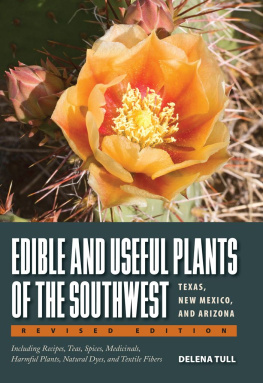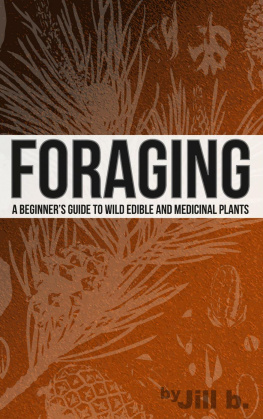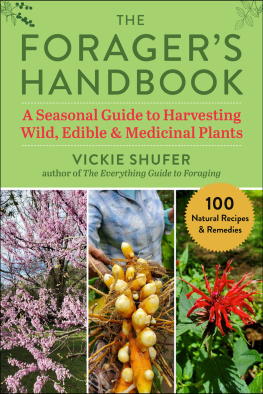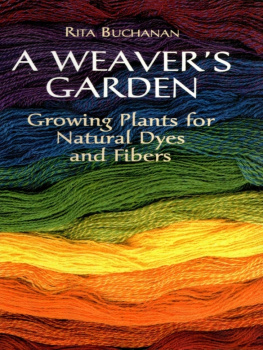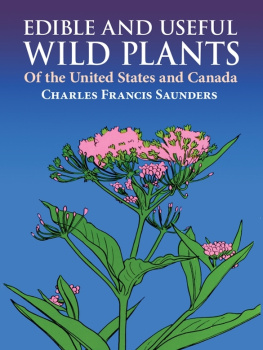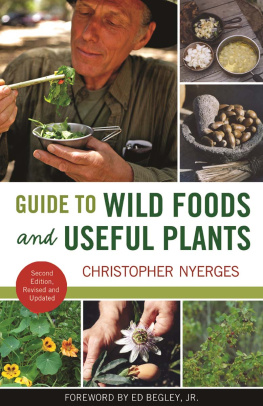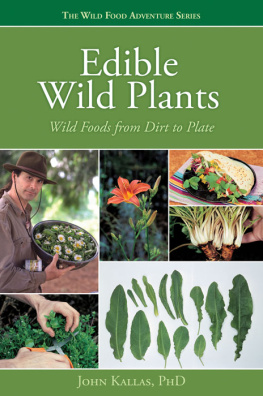
Edible and Useful Plants of the Southwest
TEXAS, NEW MEXICO, AND ARIZONA
Revised Edition
Including recipes, teas and spices, natural dyes, medicinal uses, poisonous plants, fibers, basketry, and industrial uses
BY DELENA TULL
Illustrations by Michael Earney, Julia Larke, Judy Teague, and Suzanne Rippe
Photographs by George Oxford Miller

University of Texas Press
Austin
The author and the publisher declare that to the best of their knowledge all material in this book is accurate. There are no warranties that extend beyond the educational nature of this book. Readers interested in consuming wild plants should consult other sources of information, including experienced botanists and literary works, before eating any wild plants. The authors and the publishers are not responsible for any undesirable outcomes that may occur for those who fail to read or heed this warning
Support for this book comes from an endowment for environmental studies made possible by generous contributions from Richard C. Bartlett, Susan Aspinall Block, and the National Endowment for the Humanities.
Passages from the writings of Bahullh and Abdul-Bah are reprinted by permission of the publishers, Bah World Centre Publications, Haifa, Israel, and the National Spiritual Assembly of the Bahs of the United States, Wilmette, Illinois.
Copyright 1987, 1999, 2013 by Delena Tull
Photographs copyright George Oxford Miller
Illustrations copyright Michael Earney, Julia Larke, Judy Teague, and Suzanne Rippe
All rights reserved
Originally published as Practical Guide to Edible and Useful Plants by Texas Monthly Press, 1987
First University of Texas Press printing, 1999
Revised edition, 2013
Requests for permission to reproduce material from this work should be sent to:
Permissions
University of Texas Press
P.O. Box 7819
Austin, TX 78713-7819
http://utpress.utexas.edu/index.php/rp-form
Library of Congress Cataloging-in-Publication Data
Tull, Delena, 1950
Edible and useful plants of the Southwest : Texas, New Mexico, and Arizona : including recipes, teas and spices, natural dyes, medicinal uses, poisonous plants, fibers, basketry, and industrial uses / by Delena Tull ; illustrations by Michael Earney... [et al.] ; photographs by George Oxford Miller. Rev. ed.
p. cm.
Originally published: Practical guide to edible and useful plants. Austin, Tex. : Texas Monthly Press, 1987.
Includes bibliographical references and index.
ISBN 978-0-292-74827-9 (pbk. : alk. paper)
1. Wild plants, EdibleTexas. 2. Wild plants, EdibleNew Mexico. 3. Wild plants, EdibleArizona. 4. Wild plants, EdibleSouthwestern States. 5. Plants, UsefulTexas. 6. Plants, UsefulNew Mexico. 7. Plants, UsefulArizona. 8. Plants, UsefulSouthwestern States. 9. Poisonous plantsTexas. 10. Poisonous plantsNew Mexico. 11. Poisonous plantsArizona. 12. Poisonous plantsSouthwestern States. I. Earney, Michael, 1937 II. Miller, George Oxford, 1943 III. Title.
QK98.5.U6T85 2013
581.6'32dc23
2013013690
ISBN 978-0-292-75412-6 (library e-book)
ISBN 978-0-292-75411-9 (individual e-book)
This is the Day wherein
the earth hath told out her tidings
and hath laid bare her treasures;
when the oceans have brought forth their pearls
and the divine Lote-Tree its fruit...
Tablets of Bahullh, page 107
Contents
List of Plates
.
.
List of Illustrations
.
.
.
Preface to the Revised Edition
A lot of changes have occurred in my life since the first edition of this book was published in 1987 under the original title, A Practical Guide to Edible and Useful Plants. Sadly, I divorced my first husband, George Oxford Miller, the main photographer for my books. I married again, and my spouse, Roger Norris-Tull, and I moved to Alaska where we had many amazing experiences, including flying in bush planes to numerous remote villages, as part of our work teaching for the University of Alaska Fairbanks. Alaska may be bigger than Texas, but it could never compete with Texas and Texans for the warmth of the people. While I sorely missed Texass beautiful array of wildflowers in the spring, I must admit that I did not miss Texas summers!
A few years ago, after over a decade in Alaska, we moved to Montana, the fourth largest state in the nation. I think of Montana as sort of a cross between Texas and Alaska. The small towns are very remote, and there are many ranchers and farmers. The seasons are extreme. I live in a high desert, so annual precipitation is very low. Montana has lots of cowboys. In fact, the Beaverhead County rodeo grounds are about four blocks from my house in Dillon. Montana cowboys are a lot like Texas cowboys, except that they dress warmer and wear bigger, woolen cowboy hats. The people in Montana are as friendly as folks in Texas, but there are a lot fewer of them in Montana, which suits our lifestyle.
Beyond the spectacular landscapes, one of the most fascinating aspects of my life in Alaska and in Montana has been discovering that many people in both states still rely on native plants for food. Twenty different indigenous languages are spoken in Alaska, and Alaska is home to 225 federally recognized tribes. Montana is home to twelve indigenous tribes. Many people in the tribes in Alaska and Montana still rely on subsistence harvest of native plants and wild animals. In fall and winter, moose and caribou are harvested in Alaska, and deer and elk are the main hunting game in Montana. In Alaska, virtually everyone spends the summer catching and preserving fish (primarily king salmon, red salmon, and silver salmon). In both states, a wide variety of wild plants are harvested for medicinal and food purposes, including fiddleheads, wormwood, and plantains. In some coastal areas of Alaska, a wide variety of kelps and other algae are also harvested.
A number of women in Alaska and Montana, particularly tribal members, weave exquisite baskets from local grasses, vines, twigs, and bark. In late summer, native women harvest berriesblueberries, huckleberries, cranberries, salmonberries (similar to raspberries), and crowberries. In Alaska, many berries grow in the tundra, within two inches of the ground. The berry harvest is backbreaking work, but wild foods are crucial to rural life. Wild berries and greens are an essential source of vitamins A and C, among other nutrients. And wild game is much lower in fat than commercial meats.
While I miss the Texas bluebonnet trail in spring, several species of lupines grow in Alaska and in Montana. While plant diversity and numbers of plant species diminishes the farther north one travels, I have been amazed at the significant number of plant species found in Texas that also grow in Montana.
Nothing can match the diverse array of wildflowers that bloom throughout the Southwest in the spring, summer, fall, and even in winter. I love the mountains in Alaska and Montana, but when March and April come around, I always long for the brightly colored roadsides of the Southwest.
About the title: I originally wrote this book when I lived in Texas, and I focused my research and writing on Texas plant species. The original publisher, Texas Monthly Press, insisted on leaving Texas out of the title of the book, and it was first published as A Practical Guide to Edible and Useful Plants. The publisher wanted to appeal to a larger market, and reasoned that other wild edible plant books also did not mention their regional focus in the title. I have always wanted the title to reflect the regional nature of the book, and was able to convince the current publisher, the University of Texas Press, to republish the book in 1999 under the title
Next page
